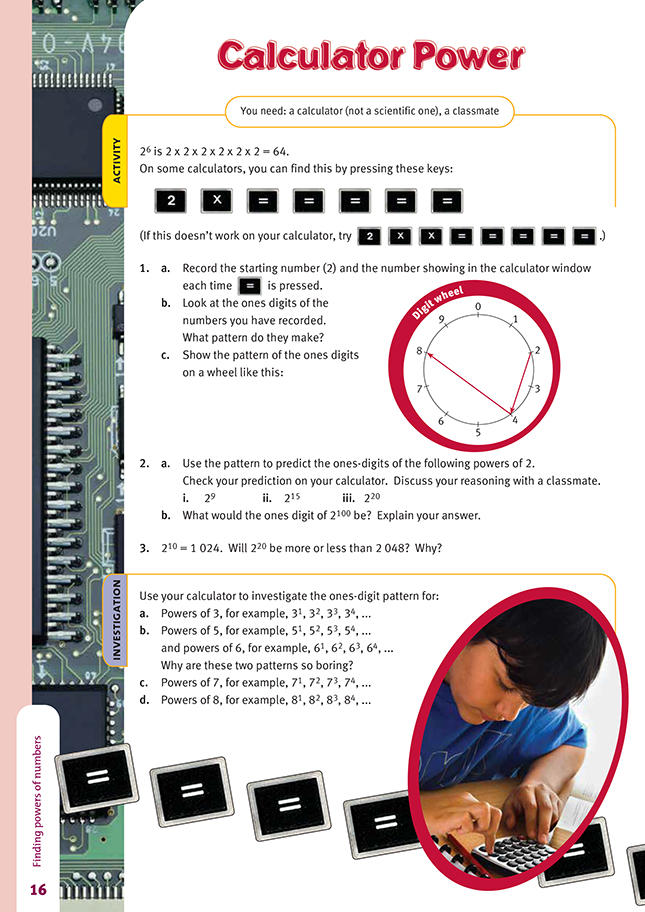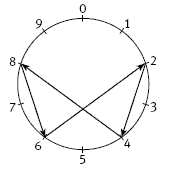This is a level 5 number link activity from the Figure It Out series. It relates to Stage 8 of the Number Framework.
A PDF of the student activity is included.
Click on the image to enlarge it. Click again to close. Download PDF (221 KB)
find powers of numbers
4
A calculator (not a scientific one)
FIO, Link, Number, Book Four, Calculator Power, page 16
A classmate
In this activity, the students use a calculator to find powers of numbers and to investigate patterns.
You could introduce the activity by asking the students how they could work out 24 on the calculator. They need to realise that 24 is really 2 (x 2) three times. On most basic calculators, you press 2 x = = = to get 24. (On some models, as pointed out on the students’ page, you may need to press 2 x x = = = ).
Point out that the pattern on the wheel is symmetrical. Later, the students can compare it with patterns produced by the other powers during the investigation. The ones digits of powers of 2 repeat the sequence 2, 4, 8, 6, … For question 2a i, the students may be able to think out that 29 is two cycles and one more
number. For 2 a ii, they could use similar reasoning or perhaps observe that the ones digit 8 can be skip-counted in fours from 23, that is, 23, 27, 211,215 . Likewise in 2 a iii, 220 can be skip-counted in fours from 24, 28, 212, 216, 220,
For question 3, if the students realise that powers of 2 have a doubling pattern, they should quickly reason that 220 is not twice 210. If they don’t, use a simpler example, such as comparing 22, which is 4, and 23, which is 8, and ask if their answer makes sense.
Investigation
The students can develop other powers in much the same way as they did in the activity. A spreadsheet could be used to compare all these powers. Ask the students to do the following: “Type 3 in cell A1. In cell A2, type A1*3. Drag down the A column to list all the powers of 3. Repeat this process in columns B, C, D, and E for the other powers and compare the columns.”
When the students are using the calculator constant, ask them to estimate: “Which power of 7 will fill up the calculator display?” (The tenth power of 7.)
Answers to Activity
1. a. 2, 4, 8, 16, 32, 64
b. They make a recurring pattern:
2, 4, 8, 6, 2, 4, 8, 6, …
c.
2. a. Reasoning may vary. The pattern is 2, 4, 8, 6, 2, … So, in every cycle of four powers of 2, the ones digit reverts to 2 (that is, 21, 25, 29, 213, and so on). So:
i. 2. 29 will have 2 as the ones digit because the power is first in the cycle.
ii. 8. 215 will have 8 as the ones digit because the power is third in the cycle.
iii. 6. 220 will have 6 as the ones digit because the power is fourth in the cycle.
b. 2100, will have 6 as the ones digit because the power is fourth in the cycle (100 can be divided by 4 with no remainder).
3. 220 is much larger than double 210 because 211 is double 210.
Investigation
a. 3, 9, 27, 81, 243 … → 3, 9, 7, 1, 3, 9, 7, …
b. 5, 25, 125, 625, … → 5, 5, 5, 5, …
6, 36, 216, 1 296, … → 6, 6, 6, 6, …
Both are boring because 5 x 5 = 25, so the 5 recurs, and 6 x 6 = 36, so the 6 recurs.
c. 7, 49, 343, 2 401, 16 807, … → 7, 9, 3, 1, 7, …
(These are the same ones digits as the powers of 3 but in a different order.)
d. 8, 64, 512, 4 096, 32 768, … → 8, 4, 2, 6, 8, …

